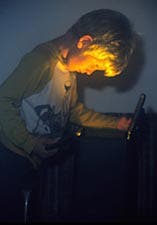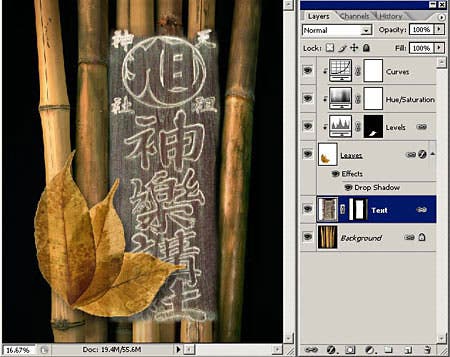Your flash can be used to simulate a variety of natural light sources, create trick effects, or simply to establish the mood of a photograph. Hard or soft light, as well as the direction of the light, will affect the feel of your photo. And sometimes, to really pull off the effect, your light source can be an integral part of your photo.
The best part? Almost all modern off-camera flash units, remote wireless triggers, and slave units have become so automated that getting the desired effect is easy. Shooting digital? Even better: You can check your results on your camera’s LCD screen and adjust the lighting position and intensity on the fly.
Here are a couple of samples of effects I accomplished with a single off-camera flash.
Looking into the magic box: To get this effect of a curious lad peering into a mystery “magic” box, I placed a small, non-automatic slave flash in the box facing upwards. The flash was covered with a diffuser large enough to fill the box’s opening. I also placed an orange acetate filter over the flash head, and used my camera’s on-board fill light at the lowest setting to set trigger the slave. To complete the effect, I attached a fairly dense diffusing filter (such as a Tiffen Black Diffusion FX #5) over the camera’s lens.
This effect–sans the diffusing filter–could also be applied to simulating the glow of a kiln or lab furnace on the face of an operator safely working with a conveniently cold apparatus. Since it’s not a real furnace, you can fool around with the filtration and exposure settings without overheating your subject.
 Shhh…there’s a prowler in the basement! To get this “prowler” at work, I put a remote trigger on my camera while my model held a small flash concealed in his hand. By holding the flash close to the breaker box, most of the light was concentrated on the box, mimicking a flashlight. To add to the mystery, I wanted my model in full silhouette, so I didn’t use fill flash.
Shhh…there’s a prowler in the basement! To get this “prowler” at work, I put a remote trigger on my camera while my model held a small flash concealed in his hand. By holding the flash close to the breaker box, most of the light was concentrated on the box, mimicking a flashlight. To add to the mystery, I wanted my model in full silhouette, so I didn’t use fill flash.
To trigger the remote flash I used a Wein WP-SSR infrared transmitter. Between it and my Nikon D70 digital SLR, I added a Wein Safe-Sync adapterto drop the transmitter’s trigger voltage to a level that’s safe for digital cameras. I like the Wein Safe-sync adapters because they let me use my older–but still serviceable–flashes with my newer cameras, many of which require low triggering voltages to avoid frying their circuitry! The latest Wein SSR transmitters meet ISO sync contact protection requirements.
The flash I used for this shot was a Morris Mini Slave Flash II. It is quite tiny, runs on two AAA cells and has a built-in photoelectric slave sensor. It’s small–you can conceal this flash in your hand easily.
If you want more of a flashlight look you can cover the front of the flash, using a piece of black paper with a round cutout. You won’t get a sharp-edged circle of light this way, but a real flashlight won’t give you one, either!
Try this!
There’s no end to remote flash trickery. You can simulate a campfire by assembling a conical structure of sticks (just like the real thing) and securing them together with hot-melt glue and some wire so you can pick it up in one piece. Leave gaps between the sticks by mixing in a few crooked ones so light will show through here and there.
Line the interior of the cone with red acetate or colored, transparent gift wrap. Frosted material works best. If you crumple the acetate and let some of it protrude through the gaps in the sticks, you’ll get a more flame-like look. Place the cone of sticks over your slave flash and you’re ready. As long as you’re not doing a close-up shot of the simulated fire, this will look quite realistic.
Afterwards, you can use Photoshop’s smudging tool on the red “flames” to make your fire look more realistic. Some fill light or off-camera flash directed at the surrounding campers will usually be needed to complete the lighting.
As you can see, you don’t need expensive gear for this kind of photo trickery. Simple, inexpensive manual slave flashes work well. Indeed, in most of these applications, even your fancy autoexposure flash, will likely work best in manual mode. Have fun!


